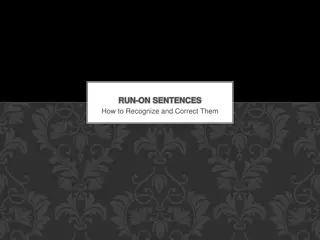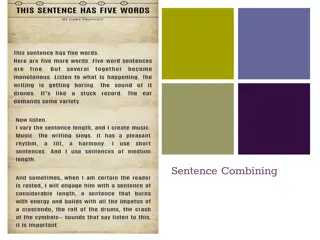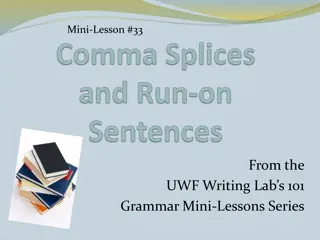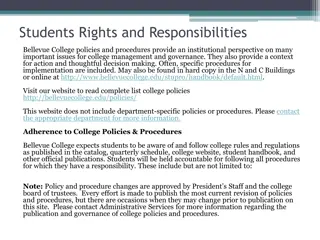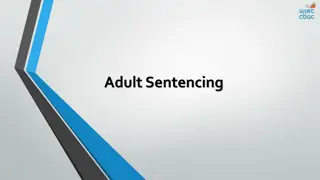Mastering Run-On Sentences: A Guide by Bellevue College Writing Lab
Improve your writing skills by learning how to identify and correct run-on sentences. Understand the differences between run-ons and fragments, explore classic run-ons and comma splices, and get hands-on practice to enhance your grammar proficiency. Discover the nuances of separating thoughts effectively in your sentences for clear and impactful writing.
Download Presentation

Please find below an Image/Link to download the presentation.
The content on the website is provided AS IS for your information and personal use only. It may not be sold, licensed, or shared on other websites without obtaining consent from the author. Download presentation by click this link. If you encounter any issues during the download, it is possible that the publisher has removed the file from their server.
E N D
Presentation Transcript
Bellevue College Writing Lab Proudly Presents How to Correct Run-On Sentences Welcome! Please sign in and take a hand-out.
What is a run-on sentence? o A run on is two or more complete sentences written as one singular sentence. o A run-on has too much information for a single sentence. It just keeps going, and going and going . o If too many thoughts are given at once, people readers can t process the information.
Run-ons vs. fragments FRAGMENTS RUN ONS Fragments are incomplete thoughts Have two or more complete thoughts They are missing a subject or a main verb. Have too many subjects and main verbs! Example: A story with adventure and excitement. Example: She told a story with adventure and excitement I could not wait to hear the end I listened the whole way through. .
Types of run-ons Classic run-on Comma splice
Classic run-on Has 2 or more complete thoughts with no punctuation, except at the end. Practice separating the thoughts: She told a story with adventure and excitement I could not wait to hear the end I listened the whole way through.
Comma Splice To splice means to join together I don t know where my knitting needles went, I thought they were in my basket. See my awesome yarn demo
Even if a sentence has commas, that doesn t mean it s complete. It could still be a run-on!
Practice: Classic, Comma Splice, or Correct? Ballet is a classical form of dance it has been performed for centuries. classic Many folk dances exist, nearly every culture has its own dances. comma splice Jazz, modern, and hip-hop all use similar steps, but the dancers perform them differently. correct!
More Practice! I m out of dishwasher soap, I need to go to the store today. comma splice Since I m going out, I might as well pick up some ice cream. correct! I won t get a giant vat of it, I ll just buy a small dish to satisfy my craving. comma splice
Fixing Run-Ons The Easy Three: periods, semicolons, and fanboys Subordinators Trimming the Fat"
The Easy Three: Period Ballet is a classical form of dance it has been performed for centuries. To correct it, separate the two complete thoughts with a period. Ballet is a classical form of dance. It has been performed for centuries.
Easy three: Semicolon Semicolon (;) more than a comma, less than a period Use it when two thoughts relate well to each other I gnaw on old car tires; it strengthens my jaws for combat against bears. Related! I fought the bear and won; some people believe unicorns evolved into narwhals. NOT Related.
Semicolon, cont. I feel sorry for the Tyrannosaurus Rex with those weenie arms, he could never scratch his nose! I feel sorry for the Tyrannosaurus Rex; with those weenie arms, he could never scratch his nose! Take note! NO additional words after the semicolon DO NOT capitalize the next word
One last word on semicolons Use semicolons sparingly no more than Once or twice per page. Up next fanboys!
For And Nor But Or Yet So Fanboys is an acronym for a specific list of words. Also known as coordinating conjunctions, these words provide a smooth transition between thoughts. Rather than a full stop (period) or a long pause (semicolon), it is a short pause plus a connecting word that makes the flow of sentences less choppy . The most common 3 from this list: and, but, or
Fanboys in practice Ballet is a classical form of dance it has been performed for centuries. Ballet is a classical form of dance, and it has been performed for centuries. ~~ I like smooth peanut butter my friend prefers it crunchy. I like smooth peanut butter, ___ my friend prefers it crunchy. ~~ I m out of dishwasher soap, I need to go to the store today. I m out of dishwasher soap, ____ I need to go to the store today.
Wrapping up the Easy Three Robins usually arrive in the spring they start to build nests at once. How do I fix this by using a period? semicolon? fanboys?
Wait a minute At this point, you may be thinking Yes, those work too! However, the rules are different with those words, so they are in a different category. Subordinators
Interchangeable? The Easy Three (period, semicolon, fanboy) are the easiest solution to a run- on sentence. Interchangeable: All of them go in the same place between the two complete thoughts. Subordinators are a bit different.
What are Subordinators? Means to make something secondary . See handout for a list of common subordinators Before, the 2 complete thoughts (aka clauses) were equal, and the easy three were the hinge. Subordinators take one of the complete thoughts and makes it incomplete.
Subordinators in Action Kyle could not eat his salad. He was allergic to onions. Two simple but complete sentences Add a subordinator to one Since he was allergic to onions it still has a subject and a verb, but now it cannot be by itself. It s what we call a subordinate clause.
Subordinators in Action cont. So now that we have made one of the sentences incomplete, we attach it to the other still-complete sentence (aka main clause). Kyle could not eat his salad, since he was allergic to onions. OR Since he was allergic to onions Kyle could not eat his salad.
Subordinators in Action cont. So now that we have made one of the sentences incomplete, we attach it to the other still-complete sentence (aka main clause) Kyle could not eat his salad, since he was allergic to onions. OR Since he was allergic to onions Kyle could not eat his salad. Notice! -The subordinate clause can go either before or after the main clause. - The clause s placement in the sentence affects if and where you use commas.
Punctuating subordinate clauses When the subordinate clause comes first, use a comma. Even though the broccoli was covered in cheddar cheese, Emily refused to eat it. Unless Christine finishes her homework, she will have to suffer Mr. B s wrath in class tomorrow. While Bailey slept on the sofa, the family dog chewed on the coffee table leg.
More punctuation When the subordinate clause comes second, you generally do not need a comma. Tanya did poorly on her exam because Giselle insisted on gossiping during their study session the night before. Jonathon spent his class time reading comic books since he already knew the material so well. Diane decided to plant tomatoes in the back of the yard where they would get the most sunlight.
Before or After? Question: How do I decide where to place the subordinate clause? Answer: Whichever is more important! Two sentences A six-foot snake slithered across the sidewalk. Rhonda gasped. I ll combine them with a subordinator at the beginning (comma or no comma?) When a six-foot snake slithered across the sidewalk, Rhonda gasped. This is grammatically correct. However, to me, a huge snake randomly appearing is more important than Rhonda s reaction, and readers tend to remember whatever they read last. So I m going to put Rhonda s gasping first. Rhonda gasped when a six foot snake slithered across the sidewalk. Note that since now the subordinate clause is last, I don t need a comma.
Fanboys versus Subordinators Maria jumped out Gino s car, for she could not tolerate his awful music. Maria jumped out of Gino's car because she could not tolerate his awful music. (comma removed, main clause is 1st) Although Sima s A in Anatomy might lead her to medical school, she might become a sculptor instead. (comma remains, main clause is 2nd) Sima s A in Anatomy might lead her to medical school, or she might become a sculptor instead.
Summing up Subordinators Subordinator + complete thought = a subordinate clause Attach the subordinate clause to *another* complete thought, then punctuate it properly, and you ll get a very spiffy sentence! They make your writing varied, sophisticated, and more complex.
Trimming the Fat Sometimes those previous methods won t be enough. Sometimes our writing isn t so easy to correct. Sometimes there are just too many words!
An Excess of Verbiage To make brownies, first get a bowl out of the cupboard and a wooden spoon and the brownie mix and preheat the oven; after preheating the oven, empty the mix into the bowl and crack two eggs and stir carefully, not too fast.
Cut it Out! In this case, there already are fanboys and subordinators. To make brownies, first get a bowl out of the cupboard and a wooden spoon and the brownie mix and preheat the oven; after preheating the oven, empty the mix into the bowl and crack two eggs and stir carefully, not too fast. Step one: break the run- on into multiple sentences Step two: eliminate repetitive phrases or ideas. Step three: Can you say it in fewer words?
Lets Do That Again! You may think your friends and family might not look forward to your birthday as much as you do, but at one time they must have, because that was the day that you were born and came into this world, which is why they celebrate your birthday with you; on that day they got a wonderful gift -- you.
Run-Ons and Your Writing: General Tips Look at the sentence length. If your writing is more than three lines long, that s probably too much. Read your sentence out loud. Yes, out loud! If you have to catch your breath before the end, it s too long. If you get lost as you re reading (out loud!), so will your audience. If you re not sure, play it safe and look for a way to make things more concise.
For More Information Visit the Writing Lab! Mon Thurs 8am-8pm Fri 8am-3:30pm Sat Sun 11am-4pm Check out our website! http://bellevuecollege.edu/asc/writing/ you can find this presentation there Visit another workshop
References Hacker, Diana. A Writer s Reference. 6thEd. Boston: Bedford, 2009. Print. How to Use a Semicolon. The Oatmeal Comics. 2010. Web. 15 Oct. 2010. Simmons, Robin. L. Grammar Bytes! Chompchompchom.com, 2010. Web, 18 Oct. 2010. Writer s Choice Grammar Workbook Grade 10. Glencoe: McGraw-Hill 1996. Print.









